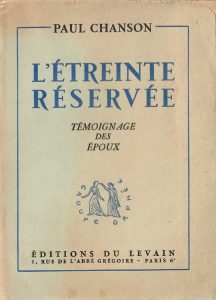 In the late 1940s and early 1950s hundreds of French and Belgian couples experimented with a Synergy-style lovemaking practice. They described it using various terms including l’étreinte réservée (reserved embrace or amplexus reservatus), l’étreinte orientale (eastern embrace) and copula reservata. This book by Paul Chanson gathers some of this testimony.
In the late 1940s and early 1950s hundreds of French and Belgian couples experimented with a Synergy-style lovemaking practice. They described it using various terms including l’étreinte réservée (reserved embrace or amplexus reservatus), l’étreinte orientale (eastern embrace) and copula reservata. This book by Paul Chanson gathers some of this testimony.
The book’s author had already published an earlier volume in 1949 entitled Art D’Aimer et Continence Conjugale, which had drawn the fire of the Catholic Church hierarchy up to and including Pope Pius XII. The Pope deemed the book too explicit, although Chanson, a devout Catholic, had written it with extreme delicacy and dignity.
In L’Étreinte Réservée: Témoignage des Époux, Chanson reveals some of the ~300 testimonies he gathered from spouses who had experimented with this approach to sex. The links to PDFs near the bottom of this page reproduce the entire book.
Summary
As the book is in French, we asked a francophone friend of this website to summarize the book for non-French readers. His notes:
This book is completely in line with Synergy, and it is amazing that lots of people have experimented and testified to its benefits. The testimonies included in the book come almost exclusively from the very Catholic circles of Northern France and Belgium.
Paul Chanson made huge efforts to have his method known. His purpose was primarily to help Catholics caught between the interdiction of counter-nature contraceptive means and the birth of too many children. These Catholics, many of whom already had large families, had only the options of (ascetic) abstinence with its psychological consequences, the unreliable Ogino-method [the rhythm method], and coitus interruptus with its masturbation and other unwanted consequences.
Chanson’s method is a way to achieve l’étreinte réservée (the reserved embrace). What is meant by this term is clearly coitus (which he calls conjonction) but without semen loss/male orgasm and without female orgasm (although the last was not very clear).
The Chanson Method
Unfortunately his actual method is not explicitly described in this book, but I gathered from the testimonies, that it entails :
- Immobile coitus, without movement (or just enough to maintain erection), and without aiming at any sexual pleasure; as a first learning step.
- Once this is achieved, the couple can proceed to ‘moderate, humble, and contained’ pleasure.
He sent his method on typed pages to whoever asked for it, for free. He also advised the following:
“When orgasm comes too close (I think he calls this tangentement), use your imagination to divert the energies.” However, when one of his correspondents complained that this failed, he answered that it is better not to try to choose something from your imagination completely unrelated to what you are doing, but rather use your imagination to concentrate, not on the sexual pleasure, but on the sentiment of love. He says it works better because a transfer then operates (from pleasure to love) instead of a restraint (refoulement).
One husband also mentioned it was useful to contract his abdominal muscles. I guess this is similar to some of the yogic techniques described in Tantric and Taoist literature.
Interestingly, Paul Chanson touts the soothing properties of coitus. In his view, touching and foreplay without coitus don’t help the deplorable nervous state (which complete abstinence leads to). Nor do they appease the senses, and may well just make things worse.
He, or one of his correspondents, describe the feeling of this type of lovemaking as the passage of the electric current, a sort of interior massage of the whole body.
One man mentions that there’s a better chance of success (i.e. to avoid ejaculation) if men empty their bladders before attempting the reserved embrace.
Surprisingly achievable
A lot of guys testified that it wasn’t difficult, in spite of the fact that most were certain, before trying, that sex without ejaculation would be practically impossible to achieve.
Chanson also mentions that people need genuine sexual education. This approach requires some psychological and moral conditioning, away from the universal focus on pleasure and emphasising more the virtues of temperance and charity.
He acknowledges that he wasn’t able to collect a lot of material from the female side of things. All this dates back to a period where lots of males (and possibly females) didn’t know whether there was any such thing as a female orgasm (and whether it was anything to pursue at all).
In his correspondence, couples who experimented profusely thanked him for saving marriages or for bringing happiness back into unions. I don’t understand why this method hasn’t become more popular and known, especially since almost all of the experiments proved successful.
Paul Chanson mentions the Oneida community in the States (as 30-year long positive experiment) and also Carezza. He sometimes suggests that males from the East (especially Persia) know, as a matter of course, how not to ejaculate. [This latter error suggests that Chanson had read Alan Watts, who widely promulgated this error.]
As a side note, I am amazed as to how well people used to write. The delicacy and precise choice of words are things most people nowadays could only dream of. And his correspondents were not all in the educated higher circles. Far from that, as he made a lot of effort to spread his ideas among the working class too.
L’Étreinte Réservée: Témoignage des Époux
The links below go to the scanned pages of the original French text. English translations of some of the self-reports can be found at: Practitioners of L’Étreinte Réservée share their experience.
Also of possible interest:
The Chanson Affair (1950-1952)
Art D’Aimer et Continence Conjugale by Paul Chanson (1949)
What if my family had known about Chanson’s “Reserved Embrace”?
